
Nykypäivän yhteiskunnassa, joka on yhä enemmän riippuvainen mobiililaitteista ja energiasta, Paristot ovat kriittisiä. litium -ioni vs. litiumpolymeeri -akku ovat suosituimpia tekniikoita, jotka ovat mullistaneet kannettavan elektroniikan, sähköautot, ja uusiutuvan energian varastointi. Heillä jokaisella on ainutlaatuisia toimintoja ja käyttöä.
Niin, Mikä ero on? Tässä artikkelissa verrataan syvyydessä litium -ionia vs. litiumpolymeeriakkua auttaaksesi sinua paremmin ymmärtämään niitä.
Litium -ionin kehityshistoria vs. litiumpolymeeriparisto
litium-ioni
Vaikka yritettiin käyttää litium-ionia jo 1960-luvulla, Vasta 1974 että m. Stanley Whittingham teki suuren läpimurton. Hän käyttää titaanidisulfidia katodina ja litiumalumiinina anodina, mikä antaa akkulle korkean energian tiheyden ja antaa sen lataamisen. valitettavasti, Näitä materiaaleja on vaikea käyttää ja herättää paljon turvallisuuskysymyksiä.
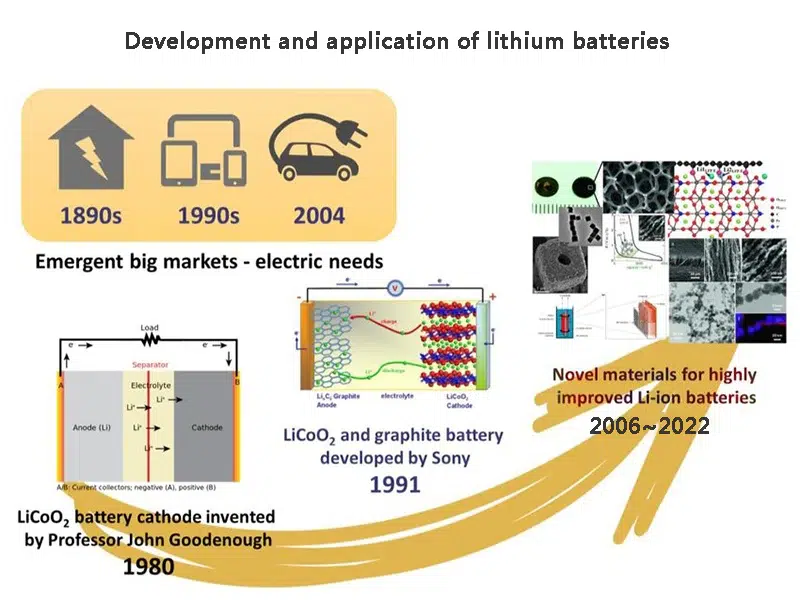
Sisään 1980, John B. Goodenough korvasi titaanidisulfidin litiumkoboltioksidilla katodina, joka yllättäen kaksinkertaisti akun energiatiheyden. Viisi vuotta myöhemmin, Akira Yoshino kehitti turvallisemman ja vakaamman menetelmän ensimmäisen litium-ioniprototyypin valmistamiseksi.
Näiden ponnistelujen kautta, Trio voitti Nobel -palkinnon kemiassa 2019 heidän panoksestaan litium-ionin keksimiseen. Tänään, Litium-ioni-akkuja käytetään laajasti tuotteissa, kuten taskulamppuissa, mobiilivirtalähteet ja sähkötyökalut.
Litiumpolymeeri -akku
Litium-polymeeri-akku keksittiin suunnilleen samaan aikaan kuin litium-ioni- ja litiummetalliparistot. Sisään 1991, Sony tuotti ensimmäisen kaupallisen litiumpolymeerin akun, joka oli merkittävä läpimurto litiumpolymeerin akulla. Sen jälkeen, Yhä useammat ihmiset alkoivat kokeilla erilaisia litiumpolymeeriparistojen muotoja, Siksi niitä käytetään nyt useissa tuotteissa, kuten kellot, kuulokkeet ja niin edelleen.

Mikä on litium-ioni?
Litium-ioni (Li-ion-akku) on edistyksellinen moderni akku, jolla on korkean teknologian ominaisuuksia. Se ei ole vain ladattava, mutta sillä on myös korkea energiatiheys. Toisin kuin muut akut, Sillä ei ole muistivaikutusta ja alhainen itsensä purkamisnopeus.

Litium-ioni on ainutlaatuinen siinä mielessä, että se sisältää litiumioneja, jotka liikkuvat edestakaisin kahden elektrodin välillä lataamisen ja purkamisen aikana. Kun lataus, litiumioulit siirtyvät katodista anodiin, Anodin täyttäminen litiumioneilla. Kun purkautuminen, Prosessi kääntyy. Katodi koostuu litiumyhdisteestä ja anodi on hiilikerrosyhdiste, yleensä grafiitti.
Tällaisia akkuja käytetään laajasti useissa sähkölaitteissa ja sähköajoneuvoissa, ja ovat myös erittäin suosittuja sotilas- ja ilmailu-.
Mitkä ovat litium-ionin edut ja haitat?
Litium-ioni ei sovellu kaikille laitteille, ja heillä on sekä etuja että haittoja. Tässä on joitain sen etuja ja haittoja.
Etu
Korkea energiatiheys
Litium-ionin energiatiheys on melko korkea, Joten niitä käytetään laajasti 3c -tuotteissa, sähköautot, energian varastointijärjestelmät ja muut kentät. Näissä sovelluksissa, Pieni akun koko ja suuri kapasiteetti vaaditaan. Siksi, Litium-ioni-akut, joilla on korkea energiatiheys, sopivat parhaiten tällaisten laitteiden tehokkaaseen käyttöön.
Matala itsepurkautumisnopeus
Litium-ionilla on alhaisempi itsensä purkamisnopeus kuin muilla ladattavilla paristoilla, vain noin 3.5% kuukaudessa. Kun varastoidaan käyttämättömään tilaan, Sisällä ei melkein ole kemiallista reaktiota ja se on erittäin stabiili. Tämä tekee niistä parempia kuin muut ladattavat akut.

Huoltovapaa
Litium-ioni ei vaadi säännöllistä hapon lisäystä, Ne eivät myöskään vaarassa turvotusta väärän veloituksen takia, Lyijyhamman huoltovapaiden paristojen kuten. Se voi olla todella huoltovapaa, Päivittäisen käytön helpottaminen ja helpompi. Samaan aikaan, Akun ylläpidon hallinnan kustannukset poistetaan, Litiumparistojen tekeminen kustannustehokkaampia.
Erilainen erityinen
Litium-ionilla on erilaisia eritelmiä, Sopii erilaisiin sovellusskenaarioihin, Jokainen eritelmä voi vastata tiettyjen tuotteiden tarpeisiin, Rikkaan valinnan tarjoaminen.
Ei muistivaikutusta
Litium-ionilla ei ole muistivaikutusta, voidaan käyttää varauksen kanssa, Ihanteellinen tila on 20%-80% matala matala maksu, joka edistää akun käyttöiän pidentämistä.
Haitta
Tarve suojella
Litium-ioni ovat parempia kuin muut markkinoilla olevat akut nopean latauksen suhteen, Hyvä suorituskyky ja pitkä akun käyttöikä, Mutta jos sitä ei hallita asianmukaisesti, On helppo ladata ja lämmön karkaava, aiheuttaen turvallisuusonnettomuuksia, Mutta akun hallintajärjestelmän olemassaolo (BMS) pystyy ratkaisemaan lämpötilan ongelman, Lämpöhallinta ja ylikuumeneminen voidaan suorittaa.
Kuljetuspalvelun turvallisuus
Monilla lentoyhtiöillä on tiukat rajoitukset litium-ionin kuljettamiseen lentokoneissa, Joten paljon merenkulkua tapahtuu yleensä laivalla, mikä lisää vaikeuksia.
Hintava
Litium-ioni on 40% kalliimpi kuin muun tyyppiset akut, Mutta kasvavan kysynnän ja akkutekniikan teknologisten vallankumouksien myötä, Näemme epäilemättä edullisempia litium-ioni-akkuja pian. Lisäksi, Vaikka etukäteen kustannukset ovat huomattavasti korkeammat kuin lyijyautojen paristot, Pitkän aikavälin kokonaiskustannukset ovat alhaisemmat niiden ylläpitovapauden ja pitkän syklin käyttöiän vuoksi, tehdä niistä kustannustehokkaita pitkällä tähtäimellä.
Mikä on litiumpolymeeri -akku?
Litiumpolymeerparistot, tunnetaan myös nimellä pehmeäpakkausparistot, ovat ladattavia akkuja. Se on samanlainen kuin litium-ioni-akut, mutta se käyttää polymeeriä, kuivaa kiinteää, ja geelielektrolyytit tyypillisten nestemäisten elektrolyyttien sijasta. Litiumpolymeerparistojen energiatiheys on korkeampi kuin muilla litiumparistoilla, ja ne ovat erityisen sopivia käytettäväksi laitteissa, joilla on tiukat painovaatimukset, kuten radio-ohjattavat lentokoneet.
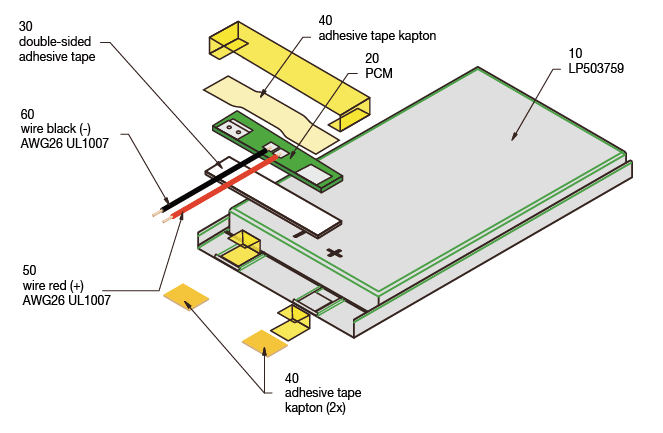
Mitkä ovat litiumpolymeerin akun edut ja haitat?
Kuten litium-ioni, Litium-polymeerakkulla on joitain etuja ja haittoja.
Etu
Korkea energiatiheys
Litium-polymeerakkulla on kaksinkertainen muiden akkujen energiatiheys. Joten se voi tarjota jatkuvan virran laitteille, jotka vaativat korkeat virrat.
Ei muistivaikutusta
Litiumpolymeerakkulla ei ole muistivaikutusta, ja sitä voidaan käyttää latauksella vaikuttamatta akun kapasiteettiin.
Hyvä turvallisuussuorituskyky
Polymeerin litium-akku käyttää alumiinirullasista joustavaa pakkausta, joka eroaa nestemäisen akun metallikuoresta, ja polymeerimateriaalien käytön vuoksi, Akku ei syttyä ja räjähtää, Ja itsessään on tarpeeksi turvallisuutta. Vaikka ongelma on, se vain puhaltaa korkeintaan, eikä räjähtää yhtä helposti kuin nestemäiset akut.
Huoltovapaa
Litiumpolymeeri -akku ei vaadi niin paljon huoltoa kuin muut paristot, Ja tämä akku on erittäin kivuton ja helppokäyttöinen.
Matala sisäinen vastus
Erityisten solujen käytön vuoksi, Litiumpolymeeripariston sisäinen vastus on pienempi kuin yleisten nestemäisten akkujen vastustuskyky, itse purkamisnopeuden vähentäminen, ja suuren virran vastuuvapauden tukeminen, joka sopii hyvin kaukosäädinmalleihin ja on ihanteellinen valinta nikkelimetallien hydridiakujen korvaamiseksi.
Paremmat purkausominaisuudet
Litiumpolymeeri -akku käyttää geelielektrolyyttejä, joilla on tasaisemmat purkausominaisuudet ja korkeammat purkausalustat kuin nestemäiset elektrolyyttit.
Joustavampi
Litiumpolymeeriparistoa voidaan tehdä erilaisiksi muodoiksi ja koot eri tarpeita eri laitteiden vaatimusten täyttämiseksi.
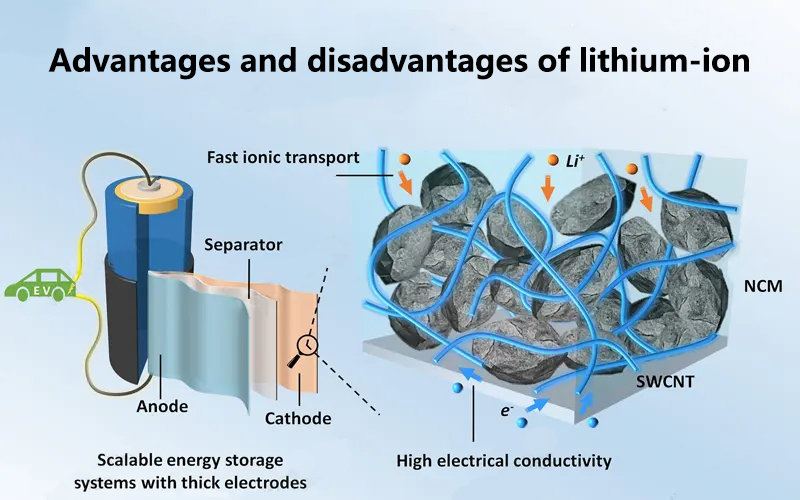
Haitta
Ylikuumeneminen
Litiumpolymeeriparisto voi helposti ylikuumentua ja vaurioittaa, etenkin korkeilla jännitteillä, joka voi vaikuttaa heidän suorituskykyyn ja pitkäikäisyyteen.
Hauras
Tällaiset akut ovat hauraita ja vaativat piirin suojaa turvallisesti. Ylivaihto tai ylikuormitus voi tuhota kemikaalien palautumisen akun sisällä, Vaikuttaa vakavasti sen suorituskykyyn.
Tarvitsetko turvallisuusmekanismin
Litiumpolymeeriparisto tarvitsee myös jonkinlaisen turvamekanismin sisäisen paineen ja jännitteen vähentämiseksi. Haittapuoli on, että se lisää painoa akkuun.
Huono monipuolisuus
Koska polymeerin litiumakku voi lisätä tai vähentää solun paksuutta todellisten tarpeiden mukaan, sen monipuolisuus on huono, joka on myös arkaluontoisen suunnittelun haitta.
Kuinka kauan litiumpolymeerparistot kestävät?
Litiumpolymeerakkulla on pitkä käyttöikä. Se kestää 900 to 1,500 latausjaksot täydellisestä latauksesta uupumukseen täyteen lataukseen uudelleen.
Litium-polymeeriakku kestää pidempään kuin litium-ioni?
Kun verrataan näiden kahden suorituskykyä, Siihen sisältyy väistämättä Llitium -ionin akku vs. litiumpolymeeri -akku, mikä on tärkeä osa vertailua. Mitä litium-ioniin,, Jos ne veloitetaan ja puretaan keskimäärin kerran päivässä, Niitä voidaan käyttää 4,000 ajat (4000/365≈10,96). Ilmeisesti, Litium-ioni-akku kestää pidempään kuin litium-polymeeri-akku. Sillä ei ole muistivaikutusta, Joten voit ladata sen, kun tarvitset sitä. Näin tekeminen pidentää lopulta sen yleistä käyttöelämää.
Mikä on parempi, Litiumioni VS Litiumpolymeeriakku?
Kun vertaat litium -ionia vs. litiumpolymeeriakkua, Saatat ihmetellä, mikä on parempi. Molemmilla modernilla akkutekniikoilla on etuja ja haittoja. Litium-ionilla on korkeampi energiatiheys, ei muistiefektiä, ja alhaisemmat kustannukset. kuitenkin, Ne voivat olla epävakaita tai jopa räjähtää korkeissa lämpötiloissa tai paineissa.
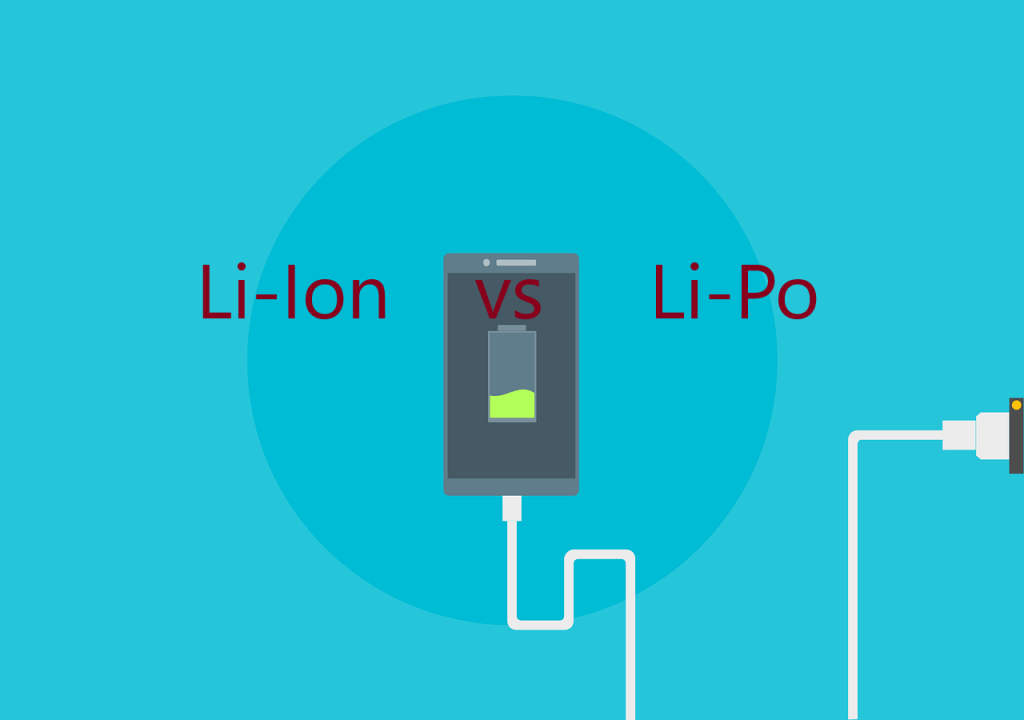
Litiumpolymeeri -akku, toisaalta, ovat kevyempiä ja joustavampia. Koska niiden rakenne on kiinteä ja kuiva, Vuotojen riski on alhainen. kuitenkin, Ne ovat kalliimpia kuin litium-ioni, on alhaisempi energiatiheys, Ja pidä lyhyempi elinaika. Viime vuosina, tekniikan edistymisen myötä, Litium-ioni geelielektrolyytteillä on ratkaissut joitain turvallisuusongelmia, tehdä niistä turvallisempia ja luotettavampia.
Mikä on ero litium-ionin ja litium-polymeerin välillä ?
Litium-polymeerparistojen ja litium-ioni-akkujen suhteen, Ne ovat monin tavoin erilaisia.
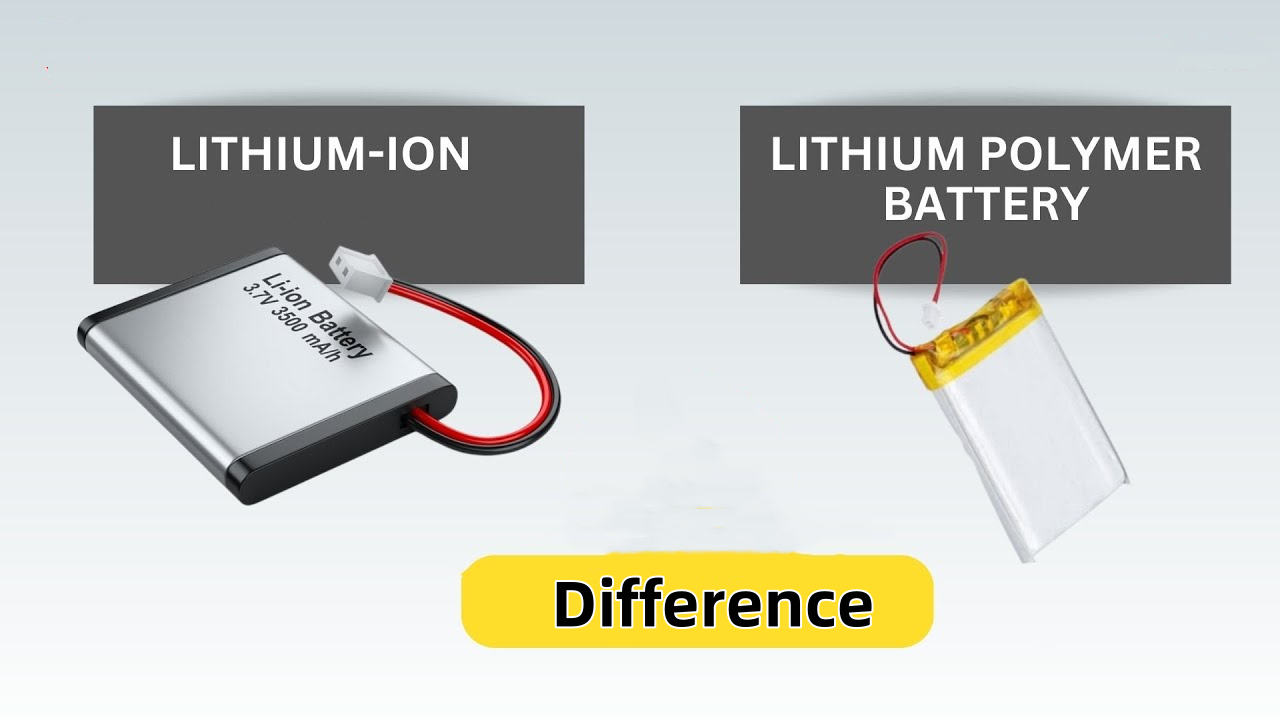
Elektrolyyttimateriaali
Litium-ion Käytä nestemäistä tai geelimäistä elektrolyyttiä, joka virtaa akun anodin ja katodin välillä, kun taas litium-polymeeri-akku käytä kiinteää tai kolloidista polymeerielektrolyyttiä, mikä antaa sen suunnitella ohuempi, joustavampi, ja monissa muodoissa.
Virransyöttö
Litium-ioni pystyy yleensä tuottamaan suuremman voiman, mikä tekee niistä sopivampia sovelluksissa, jotka vaativat suurta energiaa.
Kustannusnäkökohta
Litium-ionit ovat kustannustehokkaampia kuin litium-polymeerparistot. Litium-ioni-akut maksavat tyypillisesti välillä $30 ja $650 jokainen, kun taas litium-polymeerin akku maksaa välillä $100 ja $3,300 jokainen, Akun laatu- ja jännitevaatimuksista riippuen.
Tilavuus
Litiumpolymeeriakkua voidaan vähentää verrattuna tavanomaiseen litium-ioniin. Tämä tarkoittaa, että samalla tilavuudella, litium-ioni voi varastoida enemmän energiaa.
Levitysalue
Litium-ionia käytetään laajasti UPS-järjestelmissä, sähköautot, aurinkoenergian varastointi ja muut kentät, mutta myös kannettaville laitteille, kuten matkapuhelimille, digitaalikamerat ja niin edelleen. Joistakin tuotteista löytyy yleisemmin litiumpolymeeriakku, kuten auton hälytysjärjestelmät, Bluetooth -kuulokkeet, ja niin edelleen.
Yleisesti, Mikä akku valita riippuu tietyistä sovellustarpeista, samoin kuin kustannusten merkitys, virran ja suunnittelun joustavuus.
Erilaiset sovellusskenaariot valitsevat litium -ioni vs. litiumpolymeeri -akku?
Vertaamalla litium -ioni vs. litiumpolymeeriakkua, Akkutyyppi, jonka haluat valita. Jos haluat akun, jolla on riittävä virtalähde, Sitten litiumpolymeerparistot ovat ihanteellinen valinta sinulle. kuitenkin, Jos haluat pidemmän voiman, litium-ioni-akku paremmilla akkujaksoilla on täydellinen valinta sinulle.
Johtopäätös
Kun taas litiumioni vs. litiumpolymeeri -akku on sama kemiallinen perusta luotettavan kannettavan teholiuoksen aikaansaamiseksi, niillä on ainutlaatuiset ominaisuudet, jotka tekevät niistä soveltuvia erilaisiin sovelluksiin. Jos sinulla on tarkempia litium -ionikysymyksiä tai haluat lisätietoja siitä, mikä sovellus on sinulle parempi, Ota yhteyttä GycxSolar -akkuteknologiatiimiin.
Usein Kysytyt Kysymykset
Mikä on parempi: litium-ioni vs. litium-polymeeri-akku?
Valinta riippuu laitteen tai sovelluksen erityisvaatimuksista; Litium-ioni tarjoaa vakauden ja energiatiheyden, kun taas litium-polymeeri-akku tarjoaa joustavuutta muodon ja koon suhteen.
Onko litium-ioni-paristot kestävät pidempään kuin litium-polymeeri-akut?
Yleisesti, litium-ionit kestävät yleensä pidempään kuin litium-polymeeri-akku, etenkin samanlaisissa käyttö- ja latausolosuhteissa.
Kuinka monta kertaa litiumpolymeeriakku voidaan ladata?
Hyvin hoidettu litium-polymeeri-akku voi tyypillisesti kestää 300 to 500 varausjaksot ennen merkittävää kapasiteetin menetystä tapahtuu, Mutta todellinen elinikä riippuu käyttömalleista ja ylläpidosta.
